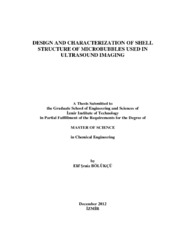Please use this identifier to cite or link to this item:
https://hdl.handle.net/11147/3539Full metadata record
| DC Field | Value | Language |
|---|---|---|
| dc.contributor.advisor | Kılıç Özdemir, Sevgi | - |
| dc.contributor.author | Bölükçü, Elif Şeniz | - |
| dc.date.accessioned | 2014-07-22T13:51:45Z | - |
| dc.date.available | 2014-07-22T13:51:45Z | - |
| dc.date.issued | 2012-12 | - |
| dc.identifier.uri | http://hdl.handle.net/11147/3539 | - |
| dc.description | Thesis (Master)--Izmir Institute of Technology, Chemical Engineering, Izmir, 2012 | en_US |
| dc.description | Includes bibliographical references (leaves: 119-128) | en_US |
| dc.description | Text in English; Abstract: Turkish and English | en_US |
| dc.description | xiv, 128 leaves | en_US |
| dc.description | Full text release delayed at author's request until 2016.01.07 | en_US |
| dc.description.abstract | The main goal of the study is to redesign the microbubble (MB) shell structure and investigate the interactions between the shell components in the mixed monolayers treated as a model for MBs’ shell in order to improve the stability. To examine effects of emulsifier type (DSPC/PEG40 St, DSPC/DSPE-PEGn) and additional components (DSPC/PEG40 St/DSPG, DSPC/PEG40 St/DSPA, DSPC/PEG40 St/DSPE) on stability, molecular interactions and morphological properties, mixtures having various compositions were investigated by Langmuir Blodgett (LB) method and Atomic Force Microscope (AFM) and Brewster Angle Microscope (BAM). For DSPC/PEG40 St monolayers thermodynamically analysis indicated that the attractive forces between the components in the monolayer of 30% PEG40 St were very strong. It was observed that addition of large amount of peg-grafted phospholipids (lipopolymer) increased the attractive forces between molecules in DSPC/DSPE-PEG1000 and DSPC/DSPE-PEG350 monolayers unlike DSPC/DSPE-PEG2000 monolayers. Additionally, the use of different phospholipid as an additional component such as DSPG, DSPE and DSPA in DSPC/PEG40 St mixture signified that intermolecular forces were influenced by the monolayers’ compositions and polar headgroups differences. It was noticed that among the ternary mixtures consisting 70% DSPC, DSPC/PEG40 St/DSPE monolayers exhibited stronger molecular interaction than DSPC/PEG40 St/DSPG and DSPC/PEG40 St/DSPA monolayers while DSPC/PEG40 St/DSPA mixtures showed stronger interaction for mixtures composed of 50% PEG40 St. However, phase separations detected at some regions for these monolayers by BAM and AFM may affect the stability negatively. Therefore, thermodynamically analysis, BAM and AFM results should be evaluated together to assess potential MBs’ shell structures. | en_US |
| dc.language.iso | en | en_US |
| dc.publisher | Izmir Institute of Technology | en_US |
| dc.rights | info:eu-repo/semantics/openAccess | en_US |
| dc.subject.lcsh | Microbubbles | en |
| dc.subject.lcsh | Ultrasonic imaging | en |
| dc.subject.lcsh | Thin films, Multilayered | en |
| dc.subject.lcsh | Atomic force microscopy | en |
| dc.title | Design and Characterization of Shell Structure of Microbubbles Used in Ultrasound Imaging | en_US |
| dc.type | Master Thesis | en_US |
| dc.institutionauthor | Bölükçü, Elif Şeniz | - |
| dc.department | Thesis (Master)--İzmir Institute of Technology, Chemical Engineering | en_US |
| dc.relation.publicationcategory | Tez | en_US |
| dc.identifier.wosquality | N/A | - |
| dc.identifier.scopusquality | N/A | - |
| item.grantfulltext | open | - |
| item.openairetype | Master Thesis | - |
| item.cerifentitytype | Publications | - |
| item.fulltext | With Fulltext | - |
| item.languageiso639-1 | en | - |
| item.openairecristype | http://purl.org/coar/resource_type/c_18cf | - |
| Appears in Collections: | Master Degree / Yüksek Lisans Tezleri | |
Files in This Item:
| File | Description | Size | Format | |
|---|---|---|---|---|
| 452783.pdf | MasterThesis | 13.2 MB | Adobe PDF |  View/Open |
CORE Recommender
Items in GCRIS Repository are protected by copyright, with all rights reserved, unless otherwise indicated.